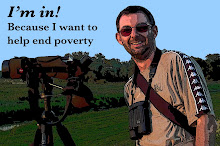Opposition to the proposed
wind farm development on western Lesvos
I have been visiting Lesvos annually for 13 years and am the author of A Birdwatching Guide to Lesvos. I know and love the island and I am fortunate
that I know the island, its people and its wildlife intimately.
I have worked within the scientific study of birds (ornithology) for
over 25 years. I have worked for the RSPB, the British Trust for Ornithology
and have been the Senior Administrator at the British Ornithologists’ Union
(BOU) for the last 15 years. At the BOU I work with leading ornithologists and
ecologists from around world including in recent years facilitating three
international conferences on climate change and the use of renewable energy technology
and their impacts on wildlife and the environment. The output from these BOU
conference can be seen on the BOU website at http://www.bou.org.uk/bouprocnet/proceedings-online/.
My freelance work as a professional bird and wildlife tour guide first
brought me to Lesvos. Over the last 13 years I have built an extensive knowledge of the island's birdlife and wider wildlife.
I also have an intimate knowledge of eco-tourism, having worked in this sector
for over 20 years.
As you can see I am well placed to be able to personally
bring together in a single submission the various impacts of the proposed wind
farm development in western Lesvos.
1. Environmental impacts
Western Lesvos comprises a mosaic habitat including large expanses of
the fragile phrygena scrub. This is
possibly the finest example of phrygena
scrub, if not in Greece, certainly within the whole of the Aegean region. This phrygena scrub on Lesvos, and
importantly the phrygena scrub in the
direct area of the proposed developments, holds 98% of Europe’s population of
Cinereous Bunting Emberiza cineracea
(Greece holds 100% of the European population of the species, with the
remaining birds on Chios, also threatened by this development). Greek
ecologists are quite rightly proud of this, but this also requires a degree of
responsibility in caring for the habitat of this species. It is estimated that
these development will impact on 50% of the population.
The phrygena scrub is also
home to a huge variety of wildlife, so these developments threaten a wide range
of flora and fauna throughout the west of the island.
There are two main threats from wind turbines in sensitive areas such
as the phrygena scrub of
western Lesvos. The construction phase and the operation phase.
The construction phase is the greatest threat to the passerine
populations of the phrygena scrub in
the proposed development area. The impacts of such developments are clearly illustrated
in the recent paper by Pearce-Higgins et
al (2012). This paper concludes:
§ The rapid increase in the development of renewable energy required to
combat climate change has lead to a proliferation of onshore wind farm
technology. These have the potential to affect birds through disturbance during
construction or collision during operation.
§ Monitoring data collected from upland wind farms located in the UK
clearly had a negative impact on population densities in the area of the wind
farms during and post construction.
§ There was little evidence for consistent post-construction population
declines in any species, suggesting for the first time that wind farm
construction can have greater impacts upon birds than wind farm operation.
§ The impacts of wind farms were largely unaffected by technical
specifications (turbine height, number or total generating power) and therefore
are widely applicable.
§ The study confirmed
that regulatory authorities and developers should particularly consider the
likely impacts of wind farms during construction phase. Greater weight should
be given to the effects of construction on wildlife in impact assessments than
at present. Mitigation measures during construction should be considered and
tested as a means to reduce these negative effects.
The operational impact of wind farms is already widely understood, and
large developments can have significant impacts on larger bird species such as
raptors, storks and herons, impacting on both local breeding populations and
migrants passing through the area (Nygard et al. 2010).
Our understanding of operation impacts is still growing and has
recently taken a huge leap forward with recent work undertaken on the vision of
birds and their ability to adjust their
rate of gain of information to meet the perceptual challenge of the
environment. That is, can a flying bird slow down sufficiently to meet a new
perceptual challenge presented by decreased visibility or a sudden increase in
complexity posed by the intrusion of obstacles into an otherwise open airspace?
(Martin, 2010).
The short answer is that many
species aren’t able to adjust to such changes in their environment. A bird’s
perception of space is very different to ours. A flying bird moves through open space populated as a part
of the natural environment in which very little, other than other birds and
animals, move. Birds are not able to compute the addition of moving objects to
their natural environment, this is widely understood with bird strikes on fast
moving aircraft, or birds unable to avoid moving cars on roads because the
speed of travel/movement is outside the understanding of a birds’ perception of
speed and movement. Moving wind turbines come within this sphere, and apart
from their great speed, they are also near-invisible when in rotation.
The potential impacts of both
construction and operation of the proposed developments are not just
significant, but are potentially huge on such a fragile ecosystem as the phrygena scrub region of western
Lesvos.
The proposed developments are also within the current Geopark status
area and Natura 2000 Special Protected Area (SPA) and impact specifically on Natura 2000 protected areas GR4110010SPA and GR4110002SCI. 95% of the proposed turbines (i.e. 140 turbines) will fall within the SPA.
Also, what impact will these developments have on the proposal to extend the Geopark status to the whole island. Or maybe the local governors and Greek government don’t care about such statuses and think nature is redundant when it comes to development. At any cost.
Also, what impact will these developments have on the proposal to extend the Geopark status to the whole island. Or maybe the local governors and Greek government don’t care about such statuses and think nature is redundant when it comes to development. At any cost.
2. Eco-tourism
So what cost might make local governors and Greek government pay
attention to?
With so much focus placed on the environmental impact of the proposed wind
farm developments, I wonder what, if any, assessment has been made on the wider
socio-economic impacts of these developments?
Lesvos is a favoured destination for birdwatchers, botanists,
geologists and general wildlife interested people. I imagine that if surveyed,
most visitors to the island would include the natural beauty of the island as a
major part of why they choose to visit Lesvos and why many return.
Lesvos is rightly the premier migrant birdwatching location in Europe.
Thousands of birders visit the island annually from across the world. But this
could all stop if the natural environment is ignored and developments of this
kind are ridden rough shot over the needs of wildlife and the concerns of those
interested in preserving and enjoying the island’s nature.
Birders are a powerful group. They deliver significant income to the
local Lesvos economy. For several resorts, in particular the key birders’
resort of Skala Kallonis, they are a vital part of the local economy with the
average weekly local benefit around €1000 per birder per week. With an estimated 3000 birders visiting the island annually, thats €3,000,000 per annum just from the international birding community. More if you extend this to those interested in wider wildlife. This is not insignificant, especially when
this spend is so localised to one or two areas of the island. One year's worth of eco-tourism income (all wildlife interest groups) is probably more than the compensation being offered by the developer (I understand this to be around €3,700,000).
To illustrate the power of birders just look at the Mediterranean
island of Malta. It too is a major migration hotspot and should be as popular
as Lesvos. But the vast majority of European birders refuse to visit the island
despite this because of the barbaric hunting of wild birds on the island which
both the local government and EU fail to act against. So we act and we do not
go there. It is estimated that Malta’s eco-tourism (mainly birders) is less
than 5% of projected levels if the hunting problem was resolved.
British birders in particular are one of the largest lobby groups in
Europe. In Britain over 1.2 million bird lovers are members of the RSPB (Royal
Society for the Protection of Birds). Earlier this year birdwatchers mobilized
in opposition to UK government proposals to cull the Common Buzzard Buteo buteo. Within weeks the UK
government had done a complete U-turn and dropped all such proposals due to the
huge scale of the opposition and ferocity of feeling against them.
Let me leave the local Lesvos governors and national Greek government in
no doubt that that they risk losing most of their eco-tourism if they fail to
protect the natural landscapes of the island and the wildlife within it.
I have already engaged British and European birders on this issue via
my Lesvos Birding website (www.lesvosbirding.com
- 60,000+ views a year). Thousands of birders all around the globe are aware of
these proposals and the scale of opposition is huge as many have already
expressed to me personally their opposition and many will make their opposition
known to environmental NGOs, national governments, etc. On behalf of birders
visiting Lesvos, past, present and future, let me express our collective
opposition to the wind farm proposals and our concern of the environmental and
socio-economic impacts these developments will have on the island.
In recent weeks birders have already begun to lobby UK and other
European bodies to take this issue up with national governments and the EU.
Greek is in debt to the rest of Europe and birders across Europe are telling
their local governments that they object to Greece’s treatment of the natural
environment (not just with these wind farm proposals) and they expect our governments
to act against Greece in order to preserve their natural environment. The UK
and Germany (two of the largest tourism groups for Lesvos) both have advanced
legislation to protect our natural environments and are central to forming EU
wildlife legislation.
I have also engaged the main UK holiday charter company flying in to
Lesvos, Thomas Cook, on this issue. In recent years charter flights have been
extended to facilitate the increased birding tourists visiting the island. I have a meeting later this month with
Thomas Cook to discuss with them their response to the possibility of losing a
significant percentage of their Lesvos customer base and have encouraged them
to discuss this with their European counterparts who similarly stand to lose
significant numbers of customers.
Can local governors and Greek government seriously risk a major
reduction in eco-tourism during their current economic crisis? Are they willing
to further add to the economic misery of their citizens by deepening the impact
of the economic crisis on areas such as Lesvos which have a greater ability to
ride the current crisis? To inflict hotel and taverna closures and increased
unemployment on a small island economy?
If the proposed wind farm developments proceed then the damage this
will inevitably do to the Lesvos natural landscape, wildlife and local economy
will be irreversible.
Steve Dudley
Author, A birdwatching guide to
Lesvos
Proprietor, Lesvosbirding.com (www.lesvosbirding.com)
References
Martin, G.R. 2010. Bird collisions: a
visual or a perceptual problem? BOU Proceedings – Climate Change and Birds.
Nygård, T., Bevanger, K., Dahl, E.L.,
Flagsted, Ø., Follestad, A., Hoel, P.H., May, R. & Reitan, O. 2010. A study
of White-tailed Eagle movements and mortality at a wind farm in Norway. BOU Proceedings – Climate Change and Birds.
Pearce-Higgins, J., Stephen, L.,
Douse, A. & Langston, R. 2012. Greater
impacts of wind farms on bird populations during construction than subsequent
operation: results of a multi-site and multi-species analysis. Jnl App.
Ecology. DOI: 10.1111/j.1365-2664.2012.02110.x
http://onlinelibrary.wiley.com/doi/10.1111/j.1365-2664.2012.02110.x/abstract
http://onlinelibrary.wiley.com/doi/10.1111/j.1365-2664.2012.02110.x/abstract























